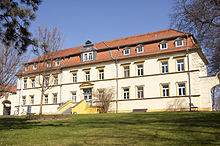Rockenthien
Rockenthien is the name of a family from the Electorate of Saxony who was raised to the German imperial nobility in 1792 .
history
The family is named after the town of Rockenthin , today a district of Salzwedel in the Altmark .
One of the early important representatives of the family is Johann Rockenthien in Langensalza , who was also called Oberamtmann as court and district councilor in 1721 , who at that time had money and grain interest income from Merxleben and from Saxon-Weißenfels fiefs in Salza .
The first lieutenant Johann Rudolph Rockenthien in the Electoral Saxon regiment Prince Clemens was raised to the imperial nobility on June 21, 1792 in Dresden during the Saxon imperial vicariate and was given a family coat of arms.
The family gained importance through the marriage of Johann Rudolph Rockenthien to the widowed Sophie von Kühn at the end of 1786, who, in addition to four underage children, had to look after the daughter from her deceased husband's first marriage at Grüningen Castle in the Weißensee district of Saxony . In addition to Niedertopfstedt, her late husband had also bequeathed Grüningen Castle to her, which her two underage sons were entitled to as feudal heirs. The widow was therefore a good match despite her five children, whose marriage to Johann Rudolph Rockenthien made social advancement to the nobility possible. In 1792, in return for payment of a not inconsiderable sum of money, he was awarded the nobility diploma for himself and his descendants. His wife's daughter, Sophie von Kühn , who was brought into the marriage , became famous through her engagement to Novalis and is still revered today. The home in Grüningen Castle now bears her name.
Novalis himself became the godfather of Günther von Rockenthien in Grüningen in 1795. At that time, his father, Johann Rudolph von Rockenthien, had already been made captain.
coat of arms
Blazon : In blue a right-turned, red griffin with a red knocked-out tongue, which holds up three golden ears of wheat in the right claw, the two outer ears of which lean downwards. On the shield there is a helmet on which, between two buffalo horns, stand three golden ears of wheat, the two outer ears of which hang down over the horns. The helmet covers are red and gold.
literature
- The coats of arms of the German baronial and noble families , Vol. 3, 1856, pp. 386–387
- Kneschke: Adels-Lexicon , Vol. VII, p. 529
